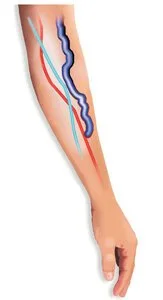
Understanding Your Access Options for Dialysis
We understand that dialysis care can be overwhelming. Choosing the right access is one of the most important parts of your dialysis journey. We’re here to help you understand the options and what they mean for your care.
Fistula
(Preferred Option)
A dialysis fistula is created by surgically connecting a vein to an artery.
This increases blood flow and causes the vein to grow stronger and larger over time, making it suitable for dialysis.
Why Fistulas Are Preferred:
Lowest risk of infection or complications
Longest lifespan
Fully beneath the skin
Uses your own natural vein
Once matured, two needles are inserted for each dialysis session
Graft
(Second Choice)
A dialysis graft connects an artery to a vein using a small piece of synthetic tubing.
It works like a fistula but may not last as long and has a higher chance of infection or clotting.
What to Know About Grafts:
Fully beneath the skin
Can be used sooner than a fistula
Requires strong blood flow to work properly
A good alternative if a fistula isn’t possible
Dialysis is done with two needles, just like a fistula
Catheter
(Temporary Use Only)
A dialysis catheter is a soft plastic tube placed in a large vein, usually in the neck or groin.
It stays partially outside your body and the tip of the catheter sits right above your heart.
Important Notes About Catheters:
Highest risk of infection and complications
Only meant for short-term use
Used while waiting for a fistula or graft
Not recommended for long-term dialysis care
Because part of it stays outside the body, it’s more vulnerable to problems
It is our goal to move patients from catheters to a permanent dialysis access option as quickly and safely as possible.
Which Access Type Is Right for Me?
Every patient is different.
We work closely with your nephrologist and surgeons to:
Help you choose the safest, most effective dialysis access for your body
Monitor your access over time to keep it working properly
Adjust your care plan if needed to prevent complications





